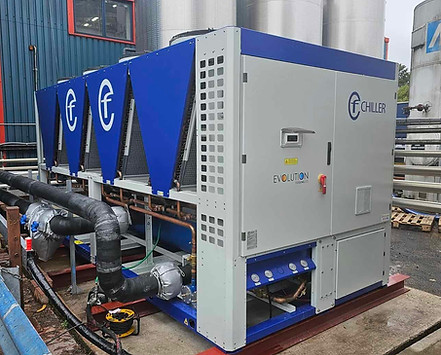How Do Our Air-Cooled Chiller Units Work?
01. Evaporation
Water is used to cool equipment and once it has done this, it enters the air-cooled water chiller and its heat is absorbed by a refrigerant liquid. By doing this, the refrigerant liquid evaporates and the newly cooled water can be recirculated and can continue cooling equipment.
01. Evaporation
Water is used to cool equipment and once it has done this, it enters the air-cooled water chiller and its heat is absorbed by a refrigerant liquid. By doing this, the refrigerant liquid evaporates and the newly cooled water can be recirculated and can continue cooling equipment.
02. Compression
The evaporated refrigerant flows into a compressor which releases the pressure of the liquid, raising its temperature and decreasing its volume. This prepares the refrigerant for the rest of the air-cooled chiller cooling cycle.
02. Compression
The evaporated refrigerant flows into a compressor which releases the pressure of the liquid, raising its temperature and decreasing its volume. This prepares the refrigerant for the rest of the air-cooled chiller cooling cycle.
03. Condensation
The vapor is directed to a condenser unit which uses coils or fins to expose the refrigerant to the outside air. Fans on the air-cooled chiller system draw cool air over this area, causing the refrigerant to condense back into a liquid.
03. Condensation
The vapor is directed to a condenser unit which uses coils or fins to expose the refrigerant to the outside air. Fans on the air-cooled chiller system draw cool air over this area, causing the refrigerant to condense back into a liquid.
04. Expansion
The refrigerant passes through an expansion valve which reduces the pressure of the liquid, cooling it down rapidly. It then re-enters the evaporator, ready to absorb more heat from the water or glycol mixture and repeat the cooling process.
04. Expansion
The refrigerant passes through an expansion valve which reduces the pressure of the liquid, cooling it down rapidly. It then re-enters the evaporator, ready to absorb more heat from the water or glycol mixture and repeat the cooling process.
The Benefits of Installing an Air-Cooled Process Chiller With CF Chiller
Cost-Effectiveness
Especially in Romania, which has a lower ambient temperature than many other countries, air-cooled water chillers are highly efficient which decreases overall cooling costs. They also require less regulatory compliance, treatment chemicals, and water purchasing than other cooling systems.
Flexibility and Scalability
At CF Chiller, all our cooling systems are modular, allowing you to scale in response to increased cooling demands further down the line. We can install additional units without any significant changes to your existing system.
Environmental Impact
Dry air coolers also reduce the environmental impact that comes with chemically treating water and the thermal water discharge associated with other types of chillers. Their lower water usage as a whole is also a key step toward having a more eco-friendly cooling system.
Maintenance and Reliability
Compared to other options, air cooled chillers tend to have lower maintenance costs. This is because they don't use as much water which can lead to scale build up and corrosion, and they don't feature cooling towers which require regular cleaning, treatment, and maintenance.

























